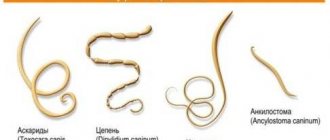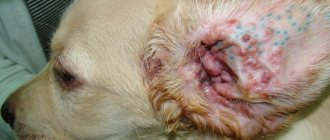piroplasmosis in dogs Your furry friend happily enjoys the summer sun and plays on the grassy lawn... This idyllic picture is fraught with one negative aspect: perhaps right now ixodid ticks are approaching your friend. They spread not only the most dangerous tick-borne encephalitis or borreliosis for humans, but also piroplasmosis - a terrible disease of four-legged friends. The peak incidence of piroplasmosis coincides with the peak of tick activity and occurs in May and August - September. When a dog is bitten by a tick, the causative agent of piroplasmosis – Babesia canis (which is why the disease is also called babesiosis) enters the blood of your pet and begins to multiply in the dog’s red blood cells.
How long does the development period of piroplasmosis last?
Depending on the size, age and state of the dog’s immunity, it lasts from several days to three weeks.
The main factors influencing the duration of the incubation period:
- weakened and young animals get sick faster and suffer the disease more severely;
- The number of ticks infected with piroplasmosis that have bitten a dog can be up to fifty pieces on one dog!
- duration of stay of the tick in the wound
- the total number of pathogens entering the blood;
- the incubation period increases if the dog previously had piroplasmosis, was vaccinated with a vaccine, or was born in an area where this disease is common (Siberia, Far East)
How does infection occur?
The carriers of the microorganism are canines (raccoons, foxes, domestic and stray dogs) . However, ixodid ticks spread the disease when they bite. They do not fall from trees, but wait for their victims in the grass. They bite mainly on the limbs, neck, and inguinal folds. The disease is dangerous not only for dogs, but also for cats and livestock.
We recommend reading a useful article on the topic: Protecting your pet from ticks: a review of the best remedies
Due to environmental problems, the spread of ticks has expanded. Now a pet can pick up a parasite not only in the forest or rural areas, but also in urban areas. In addition, geographically, ticks inhabit almost the entire planet .
- Ticks live with inactive Babesia all their lives; they can go without feeding for a long time. After a bite, the parasite injects secretions into the blood that help relieve the pain of the process. During the day he drinks blood. At this time, infection has not yet occurred.
- After this, the tick begins to actively feed, laying a granuloma (crust) around the wound; during the absorption of large red blood cells, the risk of activating Babesia and their passage into the bloodstream increases.
- If a dog is bitten by another pet infected with piroplasmosis, then the risk of infection is no less than the possibility of infection from a tick.
Babesia multiply quickly and reside in red blood cells . They feed on hemoglobin, which destroys the cell from the inside. The rapid course of the disease is due to the rapid proliferation of pathogenic single-celled microorganisms. After the walls of red blood cells are destroyed, microorganisms enter the blood and new ectoparasites that bite the pet take them for themselves. And then the already infected larvae are laid.
Signs of piroplasmosis in dogs
- general weakness, lethargy
- temperature increase to 40 - 42 degrees
- dark, almost black urine, or red urine (a sign of kidney damage)
- pale mucous membranes
- in some cases there is an enlargement of the liver
- often piroplasmosis is accompanied by diarrhea and vomiting, sometimes with blood
- difficulty moving, convulsions, paralysis of limbs
In the early stages, dog owners are not very concerned and do not visit the veterinary clinic. The insidiousness of the disease is that after a few days the dog gets better, but on the 6-7th day the sudden death of the animal is possible.
If left untreated, the dog's condition worsens significantly, it refuses to eat, and its urine becomes dark, greenish-brown, or even black.
The color of urine is the most striking symptom of canine piroplasmosis , however, in the summer, when infection occurs, owners rarely see a change in the color of urine, which is why contacting a veterinarian is delayed.
Diagnostics
Before starting treatment, it is necessary to conduct diagnostic studies and confirm the diagnosis. First, the veterinarian interviews the owner and examines the dog for any skin lesions from the tick bite. Next, he prescribes clinical and biochemical blood tests to assess the pet’s condition.
Laboratory signs of piroplasmosis:
- decrease in hematocrit;
- increase in globulins;
- increased bilirubin and ALT;
- platelets and leukocytes are within normal limits.
The disease can be detected by microscopic examination of a blood smear. The presence of parasites is indicated by paired pear-shaped formations inside the red blood cells. Blood is drawn from a vein and stained according to Romanovsky-Wright. Also, the disease can be diagnosed using the PCR method.
Treatment of piroplasmosis in dogs
Without timely treatment, the mortality rate among dogs from piroplasmosis reaches approximately 98%.
Directions for treating dogs for piroplasmosis:
- The use of certain medications - azidine, berenyl, veribene, imidosan, imizol, pyrosan, pyro-stop, forticarb, imidocarb - these drugs destroy the parasites themselves at the first stage of treatment. These drugs are followed by a toxic period, accompanied by massive death of parasites and affected red blood cells. Other measures are aimed at eliminating the consequences of exposure to parasites.
- Auxiliary therapy to maintain the body, depending on disorders of the general condition - the use of hepatoprotectors, heart medications, vitamins.
- Alkalinizing forced diuresis to prevent and directly treat disease complications. A couple of hours after the injection of a specific medicine, the death of Babesia begins, the affected red blood cells are destroyed, toxicosis sets in, blood clotting is impaired, the remaining cells are removed through the kidneys, the renal tubules become clogged, which causes a complication - renal failure in dogs. Early treatment is very important - recovery will occur within a few days; in advanced cases, the elimination of complications is delayed for several weeks and does not always lead to recovery.
- Plasmapheresis and hemosorption. They allow you to cleanse the blood of toxins, damaged blood proteins, and broken red blood cells.
Preventive measures
The best preventative measure for such a complex disease is to avoid hanging out in high-risk areas during a certain season (mid-spring - early autumn). Avoid walking in forested areas, parks, and country houses. If possible, the dog should run in special collars; it is recommended to buy an anti-parasite spray.
It is important to treat your pet with drops against ixodid ticks once a month, preferably when it is warm. Modern veterinary medicine offers vaccination against ticks, but there is a drawback - it does not provide a 100% guarantee against infection.
After a walk in the grass in nature, it is important to inspect your pet for ticks. You should especially carefully examine the thin skin behind the ears, on the neck, groin and armpit area. Ticks often get stuck between the fingertips. There are many drops that are applied to the dog's withers. It is optimal to use several protective agents at once. You can bathe your pet with special bactericidal and insectoacaricidal properties.
Consequences and complications of treatment of piroplasmosis in dogs
Complications of piroplasmosis:
- renal failure
- heart failure
- liver inflammation
- ischemic brain damage
- anemia
- CNS damage
Complications vary in severity, for example, seizures are rare, but almost always fatal, and renal failure is common. If urine does not form at all, then saving the dog is difficult and expensive, but if urine is formed, then with the use of modern dialysis measures there is a chance of recovery.
The best result for protecting the kidneys is plasmapheresis and hemosorption immediately after the start of specific therapy.
Intoxication caused by parasites has a devastating effect on the liver and nervous system. Inflammatory processes form in the brain and liver. Damage to the central nervous system occurs in the form of convulsions, which turn into coma and end in death.
What changes are observed in the animal’s body?
When microscopic parasites penetrate a dog’s blood and actively multiply there, many negative changes occur in the body. Red blood cells are destroyed, a lot of hemoglobin is released, which the kidneys and liver are unable to process. As a result, it breaks down directly in the dog's bloodstream, and its breakdown products are very toxic. They disrupt the normal functioning of many important systems of the body, disrupting the conductivity of blood vessels, and causing cardiovascular failure.
Severe anemia occurs, which leads to oxygen starvation of all internal organs and disrupts liver function. Pulmonary edema occurs, and even if the animal is urgently hospitalized, serious complications are possible. If there is no treatment as such or it was not started in a timely manner, the dog’s chances of recovery are reduced to zero.
During the breakdown of red blood cells, the lungs and heart work in extreme conditions. Veterinarian advice: be attentive to the behavior and well-being of your pet if it has been bitten by a tick. Very often, owners note the instant death of their pet, which is provoked by piroplasmosis. If your dog is acting strange, be sure to take him to the vet. It is impossible to cure an animal from such a disease at home.
Chronic piroplasmosis in dogs
Increasingly, the disease in dogs takes on a chronic form, this is due to the fact that with piroplasmosis the immunity in dogs is not sterile. After recovery, parasites continue to live in the body, and in some cases, when the immune system is weakened, an active form of the disease may develop again.
Causes of chronic disease:
- increased immunity - in this case, the active form of piroplasmosis does not manifest itself
- reduced immunity, when after treatment an increased number of parasites remains
- several cases of previous piroplasmosis
- previous piroplasmosis and subsequent stress or other disease that has reduced the body’s resistance
Symptoms of chronic piroplasmosis:
- anemia
- weakness, lethargy
- slight jaundice
- disorders of the kidneys and liver
When making a diagnosis, the fact of previous piroplasmosis is taken into account, and sometimes it is possible to isolate parasites in the blood.
What is the causative agent
Piroplasmosis is caused by the single-celled parasite Babesia (genus Babesia). They are carried and transmitted by the bite of ixodid ticks, which live in fields, parks, forests, even in city flower beds. This type of parasite has not been fully studied; scientists continue research. At the moment there is a certain classification of pathogens of piroplasmosis:
- large (3 – 5 mm);
- small (less than 3 mm).
In Russia, the most common large babesia is Babesia canis. The parasite develops with a change of two owners: the main and intermediate. In the main body, sexual reproduction occurs, in the intermediate body, asexual reproduction occurs. Domestic dogs, foxes, wolves, jackals and other representatives of the canine family can act as intermediate hosts.
In their blood, parasites multiply by fission, creating several daughter cells inside the red blood cell. After the parasite grows, the red blood cell is destroyed, the protozoa multiply further and infect new red blood cells.
The hosts of the parasites are ixodid ticks. The affected blood enters their stomach when they feed on the body of the sick animal. In the intestines of the tick, sexual formation and development of babesia occur, and then the parasites pass into the tick tissue, settle in the ovaries, and then into the eggs. It turns out that one female is capable of producing several hundred infected offspring.
Characteristics of the disease and its danger
3-6 days after the first signs and symptoms of piroplasmosis appear in dogs, treatment is ineffective. This blood parasitic disease is caused by Babesia (pyroplasmas), intracellular parasites that attack red blood cells (erythrocytes). Their waste products poison the body, and constant growth destroys cells.
Red blood cells are courier cells. They are responsible for the delivery of oxygen and the absorption of carbon dioxide. When they are destroyed en masse, hypoxia (lack of oxygen) occurs, which can lead to brain death.
Trying to compensate for the excess of carbon dioxide and the lack of oxygen, the organs of the respiratory and cardiovascular systems begin to wear out. The animal may die due to oxygen deficiency.
Due to intoxication, the liver, spleen and kidneys responsible for metabolism are affected. The destroyed cells clog the kidney tubules, forming blood clots.











